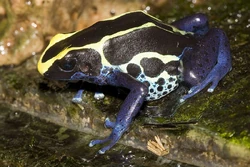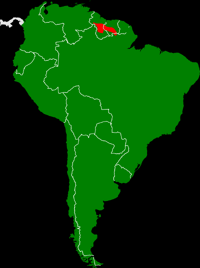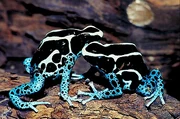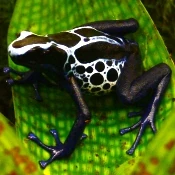| Dyeing poison dart frog | |
|---|---|
 | |
| Physical description | |
| Binomial name | Dendrobates tinctorius |
| Habitat | Tropical rainforest |
| Lifespan | 15-24 years |
| Average Size | 3-5 cm (1.2-2.0 in) |
| Average weight | 11 grams |
| Diet | Insectivorous |
| Conservational Status | |
| Status | Least concern |
| IUCN status | 3.1 |
| Scientific classification | |
| Kingdom | Animalia |
| Phylum | Chordata |
| Class | Amphibia |
| Order | Anura |
| Family | Dendrobatidae |
| Genus | Dendrobates |
| Species | D. tinctorius |
| Distribution | |
| Distribution of species | Guyana, French Guyana, Brazil |
 | |
The dyeing poison dart frog (Dendrobates tinctorius) is a species of poison dart frog in the family Dendrobatidae. It is one of the largest species of poison dart frogs, along with Phyllobates terribilis and bicolor. The dyeing poison dart frog's habitat is in decline, but it remains common in suitable locations. It is found in Guyana, French Guyana, and northeastern Brazil.
Etymology[]
This frog's common and scientific names may be somewhat confusing. The common name "dyeing" poison dart frog is quite frequently mispelled "dying" poison dart frog. However, the common name in reality comes from the fact that it serves an interesting cultural role to some indigenous tribes, not because the frog is about to meet its maker. Native tribes carefully wipe the frogs on the feathers of young parrots, causing them to change colour. The scientific name comes from the Greek word tinctorius, meaning "to soak in dye".
Physical Description[]

The "Powder Blue" morph of the dyeing poison dart frog.
According to official figures, the dyeing poison dart frog is the third-largest species of poison dart frog, but there is some overlap with other large dendrobatid species. Typically, D. tinctorius reaches 3.5 cm long; however many of the larger morphs can reach 5 cm in length or slightly bigger.
Dendrobates tinctorius is one of the most variable of all poison dart frogs. Typically the body is primarily black, with an irregular patter of yellow or white stripes running along the back, flanks, chest, head, and belly. In some morphs, however, the body may be primarily blue, primarily yellow, or primarily white. The legs range from pale blue, sky blue or blue-gray to royal blue, cobalt blue, navy blue, or royal purple and are typically peppered with small black dots. The yellow-backed morph is almost entirely yellow and black, with only a few specks of white on the toes. Another unique morph, the Citronella morph, is primarily golden yellow with tiny splotches of black on its belly and royal blue legs that have no black dots.
Males are typically smaller and more slender than females, but they have larger toe discs. The toe discs of female dyeing poison dart frogs are circular while those of the males are heart-shaped.
Relation to D. azureus[]

The Sipaliwini Blauw morph.
Dendrobates tinctorius and Dendrobates azureus are extremely similar in terms of appearance, anatomy and genetics. Some sources state that azureus is a colour morph of D. tinctorius, while others believe it to be a separate species. D. azureus bears an uncanny resemblance to the "New River", "Oyapock", and "Sipaliwini blauw" morphs; the latter shares its range with the Okopipi and the two in fact may be variations of the same frog. Unlike the three tinctorius morphs, however, D. azureus has vertical shoulder blades, as opposed to the shoulder blades of D. tinctorius which point slightly outwards, giving it an extremely angular appearence. The Okopipi, however, also has a somewhat angular appearence, and the difference may not be noticeable unless the two are placed beside each other. The two frogs' toxins also differ slightly.
Dendrobates tinctorius variability may serve as evidence for azureus being a subspecies or colour morph; the extreme similarity and very minor differences in appearence and anatomy also serve as evidence. However, neither side of the debate can provide conclusive proof.
Whether the two species are one or separate remains a matter of debate.
Poison[]
Dendrobates tinctorius can be quite toxic members of the genus Dendrobates. It is closely related to the more toxic Okopipi (Dendrobates azureus), and like it, it can produce Allopumiliotoxin and Pumiliotoxin. Including Allopumiliotoxin 339A, a highly toxic alkaloid.
Pumiliotoxin is deadly in high concentrations. Pumiliotoxin is weaker than Allopumiliotoxin and especially batrachotoxin, with a lethal dose of 2 mg (D. tinctorius carries about three-quarters of a milligram to one milligram). There are three different types of this toxin A, B and C. Toxins A and B are significantly more toxic than C. Pumiliotoxins affect the body because they interfere with muscle contraction in the heart and skeletal muscle. The toxin works by affecting the calcium channels. Some of the symptoms of pumiliotoxins are partial paralysis, having difficulty moving, being hyperactive and in some cases it can result in death.
Reproduction[]

Male tinctorius cobalt calling
Male courting female in captivity.
Dendrobates tinctorius breeds in large gatherings during the rainy season. The male's call is a quiet, musical buzzing or noise akin to a cricket or grasshopper. Females approach the loudest callers and signal being sufficiently impressed by stamping their hind feet. The male leads the male to a suitable site for ovipositioning, typically in a shallow puddle or within the damp leaf litter. One parent (normally the male, but occasionally the female) will guard the eggs and moisten them with their own urine. The eggs hatch after approximately two weeks, climbing onto their parents' backs and sticking to them via specialized mucus. The adults then carry their tadpoles to bromeliads and deposit them in the centre. The adults remain on guard; the tadpoles feed on mosquito larvae and other small food items that inhabit their nurseries.
In Captivity[]
The dyeing posion dart frog is valued as a pet. It is one of the boldest and friendliest of the dendrobatids, is easy to breed, sociable, and in its cobalt and powder blue forms, is relatively inexpensive. The other forms are not as commonly offered for sale and will likely be more expensive.
Just like all poison dart frogs, they require a small amount of ventilation, but a large amount of humidity. Therefore, they should be given a completely glass vivarium with an opening glass top. Lift the top every day and squirt the environment with a handheld spray bottle, using bottled water, as tap water containes chemicals like chlorine, which can burn the frogs' skins, and flouride, which is toxic to them. Alternatively, you can use a fog or drip system to moisturize the frogs- but again, only fill it with bottled water. Moisturize the frogs from twice a day to once every other day, depending on how humid the surfaces look. Provide humidity at least every other day, or the frogs will die.
Temperature is another problem- the dyeing poison dart frog is sensitive to high temperatures. Keep the vivarium between 70 and 80 degrees- room temperature or slightly higher. They can be aggressive to unfamiliar frogs- introducing new ones must be done with caution and when the residents may not be as defensive of their territory- after a slight remodel of their vivarium, for example.